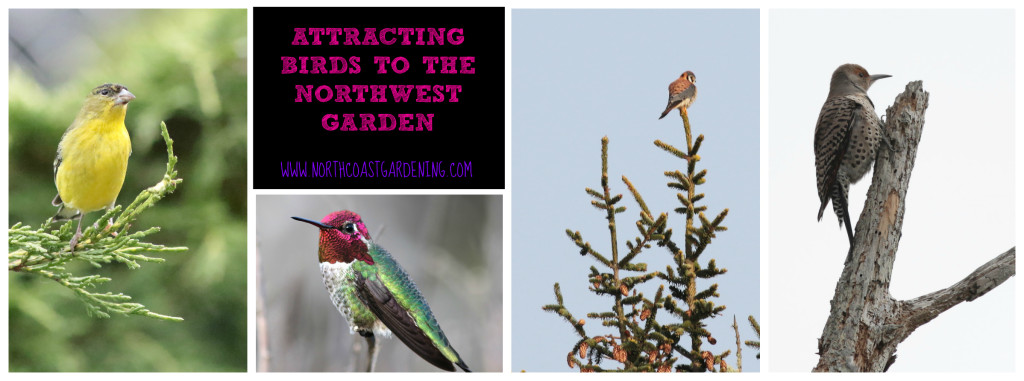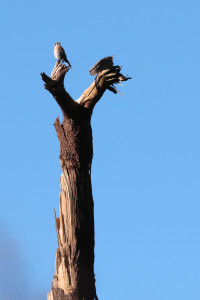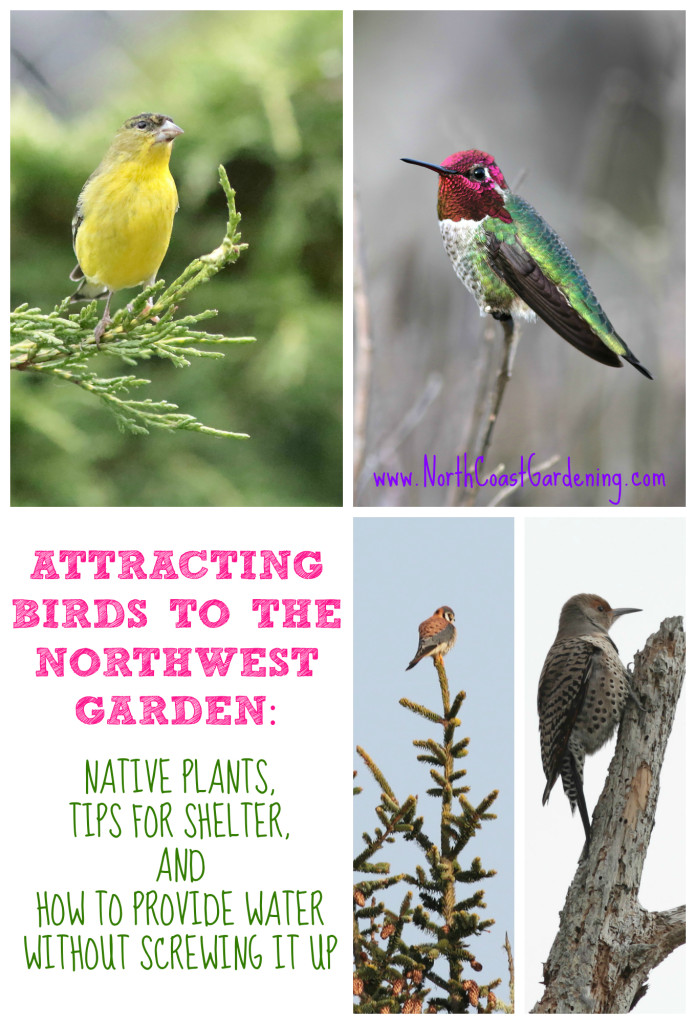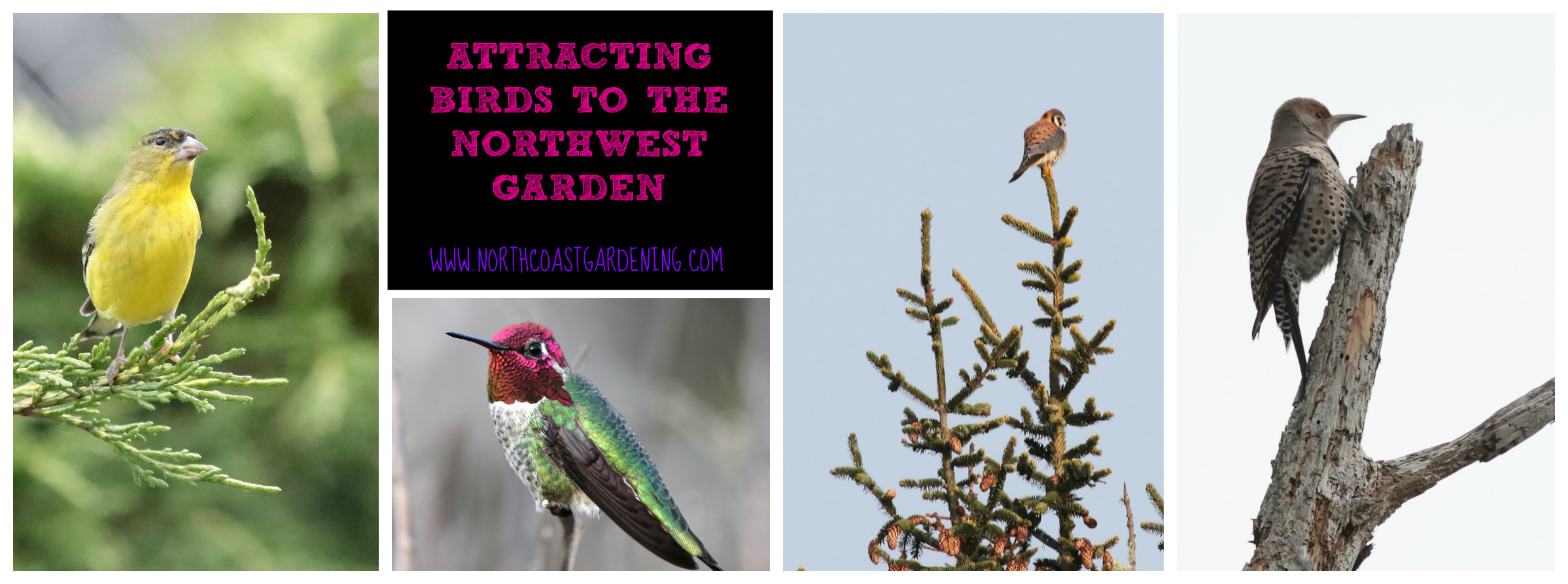
Watching birds swoop and listening to them sing are some of the many joys of gardening. But hanging up a few feeders isn’t enough to create a true backyard habitat for birds; inviting them to come and “stay a spell” takes careful consideration of their needs. So what exactly do you need to do to keep birds hanging around your yard and garden?
What birds need in a habitat garden
Birds basically need three things to survive: water, food and shelter. So how can we, as gardeners, provide these necessities for the birds who visit us?
Water sources: Birds need water for two main reasons: drinking and bathing. The drinking is a no-brainer. But few realize how important bathing is to keep their feathers in shape. At any rate, supplying water can be as simple as a birdbath or as elaborate as a pond with a waterfall. A birdbath or fountain is the simplest way to start, and it makes a great addition to the backyard or garden, since they come in all shapes and styles. Having a bird bath in your yard will attract not only the birds that are at your feeders but other wildlife as well, such as dragonflies and peaceful honeybees.
The birdbath you chose should be pretty shallow, with most of it an inch or shallower for smaller birds. If you birdbath doesn’t have gently sloping sides which make an easy “beach” for birds to land and gently get in, adding some smooth rocks or pebbles can help make a landing perch. Make sure you wash the bath out once a week and refresh the water daily. Place it away from cover so cats can’t lurk, but near enough to trees for birds to have a safe place to scope out the joint before moving in. (More about providing water for wildlife here.)
Food: The best way to feed the birds is to use as many native plants as possible in your garden. Not only do native plants provide nectar and berries at the right times of year, but they also host the native insects which birds use as a major food source, especially when nesting and raising the baby birds who become next year’s flock. Try snowberry, evergreen huckleberry, elderberry, flowering currant, and Oregon grape for nectar or berries; but pretty much any native will be a win. (More on great wildlife-attracting plants for the coastal Northwest here.)
Many people recommend against using feeders because it’s best for birds to find the nutritious natural food sources. But if you want to use a feeder to bring them up close where you can show them to your kids and appreciate their splendid qualities, choose a high quality bird seed (more on that here – and some DIY recipes). If you put a type of seed the birds don’t like, they’ll just pitch it on the ground, which attracts rodents. A surefire hit with most birds is black oil sunflower seeds. Chickadees love sunflower seeds, gold finches love nyjer thistle, and for even more variety, hang a suet cake and watch the woodpeckers come. (Gen’s note: I use this feeder which has multiple barrels so I can attract different kinds of birds with only one feeder.)
Make sure your feeder has a waterproof roof (or get a weather dome) because damp seed can cause molds which are toxic to birds. Place your feeders about 10 feet away from low shrubs that could hide a predator, such as a cat – but place it near enough to trees or hedges so there’s a place to escape should a hawk fly by looking for lunch.
To keep your feeders disease-free, clean them twice a month with a mixture of 10% household chlorine bleach and 90% water. Rinse well and dry thoroughly after washing. Also, clean around the base of your feeders so waste and seed casings don’t pile up and attract rodents.
Shelter and cover: Birds need places where they feel safe, eat, hide, build nests to raise their young, or even just rest in the shade. As people take over more and more of birds’ habitat, it makes it more difficult for them to find shelter. This is where you, as a concerned gardener, come in. You can provide shelter for them by adding structure and cover to your garden.
In this, to invite a greater diversity of birds to your yard, you will need a wide range of habitat. You can grow low ground covers, perennial flowers, grasses, shrubs and conifers (conifers, with their congested branching habit, provide especially high-quality cover), and trees. And a humble brush pile in a quiet corner of your yard could be  used by chickadees, sparrows, wrens, thrushes, towhees and quail.
used by chickadees, sparrows, wrens, thrushes, towhees and quail.
If you’re lucky enough to have a home in and around a forested area, then your property is already providing shelter for numerous birds. The upper canopy might be home to flycatchers and pine siskins. They eat the insects and seeds found in the trees. In the middle canopy, you may have woodpeckers, sapsuckers, and owls. The lower canopy and shrub layer you’d find brown creepers, nuthatches and chickadees. In the ground vegetation and pecking through the duff you might find towhees, thrushes, and wrens. If you have a dead tree (also called a ‘snag’) that isn’t a hazard, leave it standing for woodpeckers and other cavity-nesting birds.
(Read more about creating shelter for birds and other wildlife here.)
Plants, trees and shrubs that attract birds
Developing a multi-level habitat in a variety of shapes and sizes is important. By having low, medium and tall trees and shrubs combined with assorted plants, you can create shelter and food for many bird species. With a wide variety of plants, it makes foraging for insects and seeds easier for the hungry birds. Below is a list of some trees, shrubs and plants you can use in your Pacific Northwest garden, and the birds they attract.
Trees and evergreens
- Noble fir, grand fir: pine siskin, chickadees, and nuthatches
- Incense cedar: chipping sparrows, hermit thrushes, siskins, flickers, nuthatches, sapsuckers and woodpeckers.
- Pacific dogwood: sapsuckers, woodpeckers, bluebirds, tree swallows, vireos, thrushes, evening grosbeaks, white-crowned sparrows, song sparrows, towhees, grouse, jays and house finches
- Bittercherry or Oregon cherry: grouse, band-tailed pigeons, flickers, jays, robins, bluebirds, waxwings, tanagers, orioles, grosbeaks, finches, mourning doves, and towhees
- Red and blue elderberry: sparrows, thrushes, warblers, orioles, bluebirds, jays, tanagers, grosbeaks, sapsuckers, woodpeckers, band-tailed pigeons, and hummingbirds
Shrubs and groundcover
- Serviceberry: woodpeckers, crows, chickadees, thrushes, towhees, bluebirds, waxwings, oriole, grosbeaks, goldfinches, juncos, grouse, and pheasants
- Wood’s rose: grouse, bluebirds, juncos, grosbeaks, quail, pheasants, and thrushes
- Snowberry: grosbeaks, waxwings, robins, thrushes, towhees, and hummingbirds
Vines and flowers
- Trumpet honeysuckle: grouse, pheasants, flickers, robins, thrushes, bluebirds, waxwings, grosbeaks, and juncos and hummingbirds
- Western columbine: sparrows, juncos, finches, hummingbirds
- Goatsbeard: hummingbirds
- Pacific bleeding heart: hummingbirds
- Lupine: songbirds and hummingbirds
- Coneflower: finches

Other things to keep in mind
- Birds aren’t really attracted to a sterile landscape. If there are some areas of the landscape that are less visible where you can leave leaf litter and duff, make brush piles, or leave logs to rot, that’s a helpful thing to do. However, even a tidy suburban garden can be attractive to wildlife, it’s all about finding the right balance between neat and natural.
- Keep invasive plants under control. Plants such as: scotch broom, pampas grass, English ivy and purple loosestrife will smother out native plants that birds and wildlife depend on for a food source. Make it a priority to remove invasives even on the far reaches of your property. It’s a wonderful gift to your local wildlife community.
- Don’t use pesticides; they kill more than 67 million birds a year. You spray the bugs, and then the birds eat the bugs, or they may sip water off plants that have pesticides sprayed on them. A poisoned bird can become weakened or lose the use of its legs if it doesn’t die immediately. Using the pesticides can also reduce the insect population which birds count on to feed their young. So choose plants that do well in your climate without spraying (again, natives are always a good bet), monitor your plants and pick off caterpillars by hand or spray water to remove aphids.
- Keep in mind that birds can’t eat the overly-large fruit of some hybrids because the berries are simply the wrong shape or size for their beaks, so plant native species if you’d like to attract fruit-eating birds.
- Consider not deadheading your flower blossoms in the late summer and fall; wait until the end of winter. If you allow them to go to seed, then this will provide the birds with high-energy food for the shortened and cooler days. If your let your parsley, broccoli and greens go to seed, you will attract goldfinches, chickadees, junco, sparrows and house finches. Planting sunflowers or millet and letting the heads go to seed will attract a multitude of birds too. Just make sure you plant them within view of a window so you can watch the birds gorge themselves on the feast.
Making your yard into a backyard sanctuary for birds and other wildlife isn’t difficult to do. Supply food, water and shelter…….and they will come!

5 responses to “Attracting Birds to the Pacific Northwest Garden”
Awesome post! I don’t live in the Pacific Northwest but can still glean tons of useful information. Birdfeeders/bird baths are getting so trendy these days! I can’t decide which one to buy. I’ve noticed this year that we have seen so many bluejays and cardinals where I live in my garden, they make me so happy. And the monarchs are back, yes, we now have milkweed but for years we didn’t have any. And the tiger swallowtails. I think they like our cherry trees though =)
Wow, good for you for doing so much to bring wildlife in! I love bluejays and keep trying to attract them in, but the last one in my neighborhood got eaten by a hawk – which I guess is also wildlife and needs to eat, but I still felt pretty sad about! Such cheering birds. I need to provide a water source, too. I haven’t found as many options locally as I would like. Thanks for stopping by Laura!
There are some great pointers here to consider. You really brought to light the predator issue. I hadn’t considered that cats are probably thinking, “Hurry up and feed the birds already”! Thanks so much for your post!
Hi,
I’m in Mendocino county and I have many birds but the song birds left and I think it’s because of the Blue Jays. There are rock dove pigeons, ravens, little mud heads, owls and woodpeckers.
Any ideas on how to get rid of the blue jays? Ravens? I won’t shoot them but they raid nests.
[…] Plant-based food: seeds, nuts, berries, pollen, fruit, foliage and twigs, nectar and sap are all good sources of plant-based food. Since birds and bugs are used to the balanced nutrition found from natural sources, this is the best way of feeding wildlife, and requires the least from you in terms of ongoing maintenance. Native plants are most likely to feed the wildlife living in your area, so if you’re unsure of what to plant, you can be sure natives will be a hit. […]